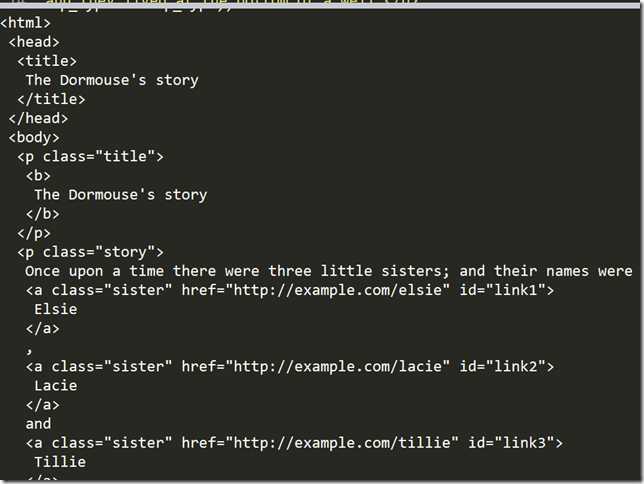之前学习了正则表达式,但是发现如果用正则表达式写网络爬虫,那是相当的复杂啊!于是就有了Beautiful Soup
简单来说,Beautiful Soup是python的一个库,最主要的功能是从网页抓取数据。
Beautiful Soup提供一些简单的、python式的函数用来处理导航、搜索、修改分析树等功能。它是一个工具箱,通过解析文档为用户提供需要抓取的数据,因为简单,所以不需要多少代码就可以写出一个完整的应用程序。
安装Beautiful Soup
使用命令安装
pip install beautifulsoup4
出现上述截图表示已经成功安装
Beautiful Soup的使用
1.首先必须先导入BS4库
from bs4 import BeautifulSoup2.定义html内容(为后边的例子演示做准备)
下面的一段HTML代码将作为例子被多次用到.这是 爱丽丝梦游仙境的 的一段内容(以后内容中简称为 爱丽丝 的文档):
html = """ <html><head><title>The Dormouse‘s story</title></head> <body> <p class="title"><b>The Dormouse‘s story</b></p> <p class="story">Once upon a time there were three little sisters; and their names were <a href="http://example.com/elsie" class="sister" id="link1">Elsie</a>, <a href="http://example.com/lacie" class="sister" id="link2">Lacie</a> and <a href="http://example.com/tillie" class="sister" id="link3">Tillie</a>; and they lived at the bottom of a well.</p> <p class="story">...</p> """
3.创建beautifulsoup 对象
#创建BeautifulSoup对象 soup = BeautifulSoup(html) """ 若html内容存在文件a.html中,那么可以这么创建BeautifulSoup对象 soup = BeautifulSoup(open(a.html)) """
4.格式化输出
#格式化输出 print(soup.prettify())
输出结果:
5.Beautiful Soup将复杂HTML文档转换成一个复杂的树形结构
每个节点都是Python对象,所有对象可以归纳为4种:
- Tag
- NavigableString
- BeautifulSoup
- Comment
(1)Tags
Tags是 HTML 中的一个个标签,例如:
<title></title>
<a></a>
<p></p>
…
等都是标签
下面感受一下怎样用 Beautiful Soup 来方便地获取 Tags
#获取tags print(soup.title) #运行结果:<title>The Dormouse‘s story</title> print(soup.head) #运行结果:<head><title>The Dormouse‘s story</title></head> print(soup.a) #运行结果:<a class="sister" href="http://example.com/elsie" id="link1">Elsie</a> print(soup.p) #运行结果:<p class="title"><b>The Dormouse‘s story</b></p>
不过有一点是,它查找的是在所有内容中的第一个符合要求的标签,看<a>标签的输出结果就可以明白了!
我们可以使用type来验证以下这些标签的类型
#看获取Tags的数据类型 print(type(soup.title)) #运行结果:<class ‘bs4.element.Tag‘>
对于Tags,还有2个属性,name跟attrs
#查看Tags的两个属性name、attrs print(soup.a.name) #运行结果:a print(soup.a.attrs) #运行结果:{‘href‘: ‘http://example.com/elsie‘, ‘class‘: [‘sister‘], ‘id‘: ‘link1‘}
从上面的输出结果我们可以看到标签<a>的attrs属性输出结果是一个字典,我们要想获取字典中的具体的值可以这样
p = soup.a.attrs print(p[‘class‘]) #print(p.get(‘class‘)) 与上述方法等价 #运行结果:[‘sister‘]
(2)NavigableString
我们已经获取了Tags了,那么我们如何来获取Tags中的内容呢?
#获取标签内部的文字(NavigableString) print(soup.a.string) #运行结果:Elsie
同样的,我们也可以通过type来查看他的类型
print(type(soup.a.string)) #运行结果:<class ‘bs4.element.NavigableString‘>
(3)BeautifulSoup
soup本身也是有这两个属性的,只是比较特殊而已
#查看BeautifulSoup的属性 print(soup.name) #运行结果:[document] print(soup.attrs) #运行结果:{}
(4)Comment
我们把上述html中的这一段修改为下面这个样子(把<a></a>标签中的内容修改为注释内容)
<a href="http://example.com/elsie" class="sister" id="link1"><!--Elsie--></a>
我们可以使用Comment同样提取被注释的内容
#获取标签内部的文字 print(soup.a.string) #运行结果:Elsie
查看其类型
print(type(soup.a.string))
#运行结果:<class ‘bs4.element.Comment‘>

